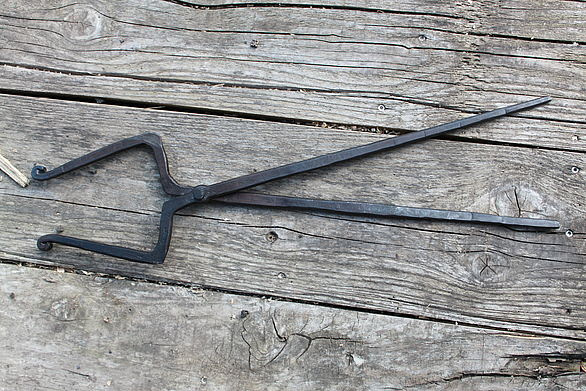-
Posts
309 -
Joined
-
Last visited
Content Type
Profiles
Forums
Articles
Gallery
Downloads
Events
Posts posted by jcornell
-
-
I've been a hobby blacksmith since 2009, using propane at home. I've built maybe half a dozen burners (T-burner, Wye Burner, Porter style burner) in that time and I just got around to building a new burner in March. I've used Mig tips in the past, but only for forge burners, I've never done mig welding.
I just discovered that some of the Mig tips in my stash are threaded 1/4"x 28, whilst the Mig tips I bought at the big box store are threaded 1/4"x20. The ones I bought at the big box store are Lincoln, whilst the ones in my stash are Tweco 14T-30.
So, my question for the day - which brands typically are 1/4"x 20 thread versus 1/4"x28? I've never seen anything in the welding literature that would tell me that different mig brands use different thread size. Is this something that everyone already knows and I'm just now catching on?
-
I have a spray bottle filled with water and a bit of dish soap. I spray my gas line from bottle to burner on a somewhat regular basis, checking for bubbles. I hate surprises.
-
-
Please be advised that if you're going to forge outdoors, the Frosty burner is a bit iffy with strong breezes. What will really kink things up is when your exhaust coming from the front of the forge gets sucked into the burner intake - you'll have a sputtering and stuttering burner then. I've largely solved this by installing a sheet metal guard that keeps the exhaust out of the burner intakes. The current shield is made from a christmas popcorn tin (lid and bottom removed). the tin is wired to the top of the frosty burner.
-
The T-burner is particularly fussy about operating outside in the wind. I took one of the popcorn tins that are typically sold around Christmas time and made it into a wind screen to protect the air intake of my t-burner, as it's running on a forge outside, under a maple tree in my back yard,.
-
I'm going to take a guess and say you don't have a flare/flame holder on the end of your t-burner. I had the same jumping - I put on a bigger flare and it went away.
-
Regarding parts - depending on where you live, you may not have easy access to a store that will let you look at plumbing fittings - so if that's the case, McMaster-Carr or Grainger is the next alternative.
-
A soft firebrick for the floor is not a good idea if you plan on using flux. Get a piece of kiln shelf for your floor - reasonably cheap, tough (flux resistant) and not a lot of thermal mass. As your forge is round, use some plain, non-scented kitty litter on the bottom of your forge before you put the kiln shelf down - it'll act as a leveler.
-
You can make a one or two brick forge with a propane hand torch. It's not optimal, but it will work. You'll be using soft, insulting fire bricks - I'd recommend the ones rated for 2600 degrees F - you can buy them at Zoeller Forge or from Axner Pottery supply, or EBay. The soft brick can easily be carved out to make a small heating chamber. I'd recommend instead that you make a coffee-can forge and make a 1/2" frosty t-burner, you'll spend about as much money over the course of a year and have a lot more versatility. PM if you want to discuss further.
-
Acklands Grainger (which appears to be the Canadian version of Grainger Industrial Supply) should suffice, or McMasterCarr, which I believe will ship to Canada. Here in the USA if I order from Grainger but pick it up at their store, I don't pay shipping - excellent source for plumbing parts and hardware not carried at the big box store.
-
Regarding your t-burner going out and then relighting. The t-burner is a very stable design, but if the exhaust from your forge is getting sucked into the air intake of your burner, you'll get stuttering or intermittent flame. I solved that (for the most part) by taking a Christmas popcorn tin, removing the lid, removing the bottom, and wiring what's left as a kind of wind screen around the top of my burner. I forge outside, so the prevailing breeze in my area blows the exhaust out of the front of my forge up over the top of the forge, into the air intake. Installing my wind screen got rid of most of the problem. It's also more susceptible to this problem before the walls are totally hot (glowing).
-
If it's really 1018, then it really doesn't have enough carbon to harden for an edged tool. I'd try it as a stump anvil or set it into a cylinder of concrete and see how it does as a knifemaking anvil. I'll defer to the hammer makers on IFI, as I've never made one from scratch before.
-
1 hour ago, Rl69 said:
The more I read the less I want a gas forge
I understand the heat sink what is puzzling to me is why a refractory designed to hold heat in soaks it up? Still learning
The steel doesn't get hot until the entire forge gets hot - so if the refractory is a heat sink, you'll spend 45 minutes to an hour getting the forge hot. After that, you're in good shape, but that's a lot of propane for the average hobbyist who forges two hours a day on the weekends (if you're lucky).
-
To amplify on Latticino's comment - hard fire brick is a heat sink. Your steel won't get hot until until the entire forge is hot.
-
okay, I'll bite, how do you test the hardness of a hammer? I watch some Brian Brazeal videos where he's using his 3# rounding hammer to smite his tools (eye punch) and it makes me cringe.
-
Unless you're planning on using it as a hand torch, how it burns outside the forge at 20+ PSI is rather irrelevant. Once you get it into the forge body, you'll have some back-pressure, which will make the performance of the burner a bit different. I suspect in the forge you'll be able to go to 30 PSI.
-
3 hours ago, Tock said:
I am new to the site and didn’t think it uploaded my pictures so I tried it 2 more times. SORRY dude! I am building a ron reil burner exactly to spec this time not just scraps that I had laying around in my garage. I will ridgidize my blanket I looked at the post on that. Do I just use refractory cement for that? I thought it was ok for less than $19 but now I realize that shortcuts aren’t working. Few more bucks to spend on this thing but i will keep building till I get it right.
Look up "fumed silica powder" on Amazon or EBay - it's a lot cheaper to mix your own rigidizer than to buy the premade stuff and pay for shipping all that water.
-
My first two forges were built from soft firebrick. It works well, until the brick breaks down because of thermal cycling. The next two forges were coffee can forges lined with Superwool HT. Forge #5 is a freon can, lined with 8# kaowool. So, yeah, soft brick works, but it's not a long-term solution.
-
In addition to the other comments - the mig tip is not tapped straight - which means it's not pointed down the center line of the burner tube. Using the drill press as tap center trick mentioned in Frosty's blueprints got me past that problem.
-
You're confusing rigidizer (which only makes the kaowool stiff) with a kiln wash or reflective coating. I've been using Kaolin and Zircopax for years now - my forge walls glow brightly, showing that the heat's being reflected. It's a consumable item - you'll need to "repaint" the inside of your forge every so often, depending on how much you use your forge. The exciting research is the zircopax and veegum mixture. I'm still waiting for a report on that.
-
In the USA there are difference categories of pipe - by way of example, Schedule 40 and Schedule 80. A schedule 80 pipe has a thicker wall. If you're trying to mount a mig tip, you MUST use a thicker walled pipe - the 1/8" Schedule 40 doesn't have sufficient Inner Diameter (ID) to tap the threads properly, while a 1/8" Schedule 80 does have the proper ID. Now, I know next to nothing about British pipes, but I'm willing to bet a cookie that if you go to a British plumbing supply house and ask if they stock thick walled 1/8" pipe nipples, you'll be able to tap for your metric mig tip without much problem.
-
Veegum T is available from my go-to supplier, Axner.com.
-
I use a thermocouple and PID style readout on my propane forge. I'm outside, and I've learned the hard way that I can't really reliably tell temperature by color when I'm forging in my back yard. The readout is valuable when I'm working weird steel - like S-7 which won't begin to move until you're above 2000 F and when welding.
-
Get the steel hotter.



Mig tip thread size 1/4"x20 versus 1/4"x28
in Gas Forges
Posted
Some further research from the WeldingCity website. If you click deeply into the specifications you'll find a parts diagram with measurements!
The 11T-35 is a tapered mig tip for 0.035 - its thread is M6x1 (which oddly enough, screws nicely into a 1/4-20 threaded opening - who knew?)
The 14T-35 is a tapered mig tip for 0.035 - its thread is 1/4-28, which will not screw into a hole threaded 1/4-20 (I tried this weekend, no dice - that's what got me asking this question).
Both the 11T and 14T tips are supposed to be compatible with Lincoln.
The Miller-Hobart tips listed on WeldingCity all appear to be threaded for 1/4-28.
Both are tapered tips - the 11T-35 is just a little bit longer than an inch long. The 14T-35 is a little bit longer than 1.5" long.